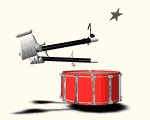













Welcome to Diddy 2.."Cymbal Swing". In finding a starting point I am going to first set the basics for what we drummers call "swing" and jazz interpretation. As many of you are probably aware, we don't necessarily interpret drum notation as it is written. We play it according to the musical idiom we are in. As the ride cymbal of a jazz drummer's setup is the main instrument upon which he or she produces their own personal feel or "Groove", the rest of the drum set is what I see as being the "Icing on the Cake"...the cymbal being the "Cake". In other words, the way the drummer plays the ride cymbal really sets forth his or her own personal feel. I personally spent many, many hours concentrating on practicing and playing my ride cymbal, hoping to eventually find my own personal feel.... something we call one's "Signature Sound" or "Groove".
In the following two examples we see two seemingly different ride cymbal patterns. The first is the way we usually see the ride cymbal pattern written.....for swing music, of course. The second is the way we jazz drummers actually play the cymbal pattern. The space between the notes of the triplet feel gives the rhythm more of a swing feeling.....the sixteenth note pattern is too stiff for purposes of today's swing.
.


I suggest playing this pattern with the hi-hat on beats 2 & 4. Concentrate on listening to what you are playing and forget about playing the rest of the drum set along with the cymbal until you hear it the way you want it to sound. One other good trick is to play it along with your metronome clicking on beats 2 & 4. This will help you hear the accented beats where they should be. Listen to how other drummers play the ride and pick and choose those attributes that will add to the way you want yourself to sound. The goal here, however, is to sound like YOU....... not like someone else.
Well, that's it for now. I'll add another tip soon so come on back. HAPPY PRACTICING!
To "GROOVES"
![]()
Back to The "Real Diddy"
Before you leave, please sign my "Guestbook"